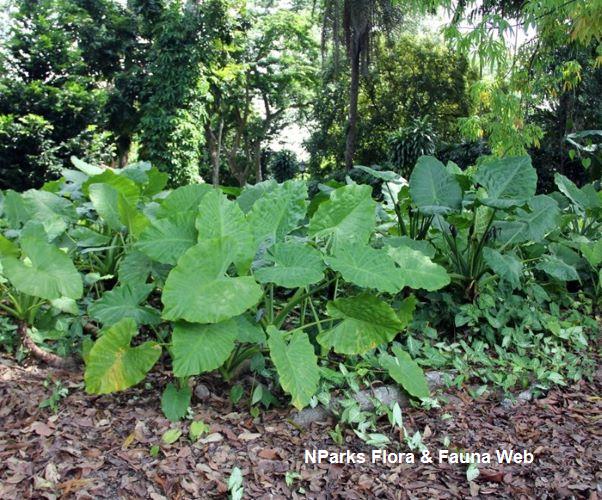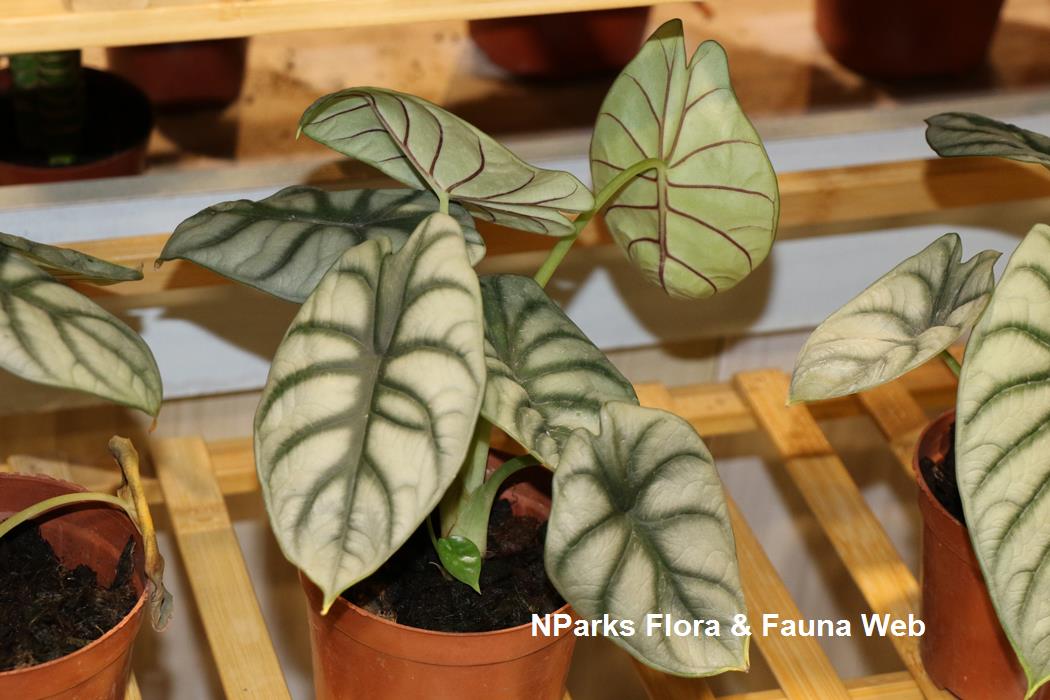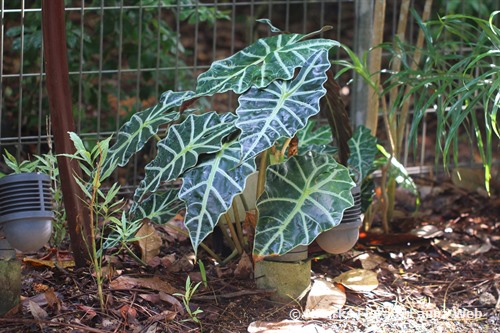
Back
Alocasia odora (G.Lodd.) Spach
| Family Name: | Araceae |
| Synonyms: | Arum odorum Roxb. ex Lodd., G.Lodd. & W.Lodd. <3>, Alocasia odora K. Koch nom. illeg. <3>, Alocasia tonkinensis Engl. & K.Krause, Arum odoratum Rieder |
| Common Name: | Asian Taro, Night Scented Lily, Giant Upright Elephant's Ear |
The Asian Taro is large perennial herb that can grow up to 2.5 m. It has a rosette of large, erect leaves and produces fragrant, night-blooming inflorescences and red berries. This species can be differentiated from the similar-looking Giant Taro (Alocasia macrorrhizos) by the closed sinus of the leaves, the shorter appendix, and production of several offshoots from the base.
Name
Classifications and Characteristics
| Plant Division | Angiosperms (Flowering Seed Plants) (Monocotyledon) |
|---|---|
| Plant Growth Form | Herbaceous Plant |
| Lifespan (in Singapore) | Perennial |
| Mode of Nutrition | Autotrophic |
| Maximum Height | 2.5 m |
Biogeography
| Native Distribution | India through southwest China, Cambodia, Laos, Myanmar, Thailand, Vietnam and east to Japan (Ryukyu islands) |
|---|---|
| Native Habitat | Terrestrial (Primary Rainforest, Secondary Rainforest, Freshwater Swamp Forest, Riverine) |
| Preferred Climate Zone | Tropical |
| Local Conservation Status | Non-native (Spontaneous (Naturalised)) |
Description and Ethnobotany
| Growth Form | It is an evergreen herb that can reach up to 2.5 m with occasional offshoots growing from the base. |
|---|---|
| Foliage | The leaves are held upright and arranged in a rosette at the tip of the stems. The petioles (leaf stalks) can grow up to 1.5 m long. The leaf blades are heart-shaped or rounded, arrowhead-shaped, growing up to 1.3 m long and 1 m wide. The sinus (indentation where the leaf stalk connects to the lateral lobes in aroids) is closed with a connected leaf blade between the lateral lobes |
| Stems | The stems are underground corms (thick, often round, modified stems) that elongate as the plant ages, either growing erect or lying along the ground with the leafy shoot curving upwards. |
| Flowers | The inflorescence is an off-white spadix comprising of an appendix (a sterile rod-like upper portion of the spadix) and tiny fertile flowers in the lower portion. The appendix is 1/3 the length of the entire spadix. The spadix is subtended by a spathe; an upper portion is open, creamy to off-white, and a bulbous, greenish-blue enclosed portion surrounding the female flowers, separated by a tight 'waist'. The upper portion of the spathe turns hood-like when the male flowers mature. The flowers are fragrant, particularly at night. |
| Fruit | The infructescence is composed of multiple globose berries that turn red when ripe. When semi-matured, the berries are covered by the greenish-blue enclosed portion of the spathe, which peels back as the fruit mature. |
| Reproductive Parts - non-flowering plant | It produces short stolons that end in brown, round tubercles (small, corm-like organs that grow into new plants). |
| Habitat | It can be found in primary and secondary tropical rain forests, bamboo thickets, riverbanks, and swamps, sometimes on limestone, at elevations below 1700 m sea level. Naturalised in Singapore, it is often found in disturbed areas along roadsides, drain canals, and forest edges, as well as among urban landscaping. |
| Similar | This species is often confused with Alocasia macrorrhizos but can be differentiated by its closed sinus on the leaves, the shorter appendix, and the production of several offshoots from the base. A. macrorrhizos has an open or naked sinus on its leaves, an appendix equal to almost half the length of spadix, and are solitary with 1 - 2 offshoots from the base. |
| Associated Fauna | The flowers are pollinated by flies of the species Colocasiomyia alocasiae and C. xenalocasiae <4>. The fruit are dispersed by birds, probably bulbuls (Pycnonotus spp.) and koels (Eudynamys spp.) <2>. |
| Cultivation | This species grows best in bright light with light shade and moist, but well-drained loamy soil. However, it can tolerate shade to full sun and sandy to clayey soils. |
| Etymology | The generic epithet Alocasia is derived from the Greek terms, a- "not" and kolokāsiā "lotus root", alluding to its similarity to Colocasia, a closely-allied genus. The specific epithet odora refers to the fragrant flowers. |
Landscaping Features
| Desirable Plant Features | Ornamental Foliage, Fragrant (Flowers) (Night) |
|---|---|
| Landscape Uses | General, Parks & Gardens, Riverine |
| Thematic Landscaping | Naturalistic Garden, Bird & Wildlife Garden |
| Usage Hazard - Cons | Toxic Upon Ingestion, Invasive / Potentially Invasive |
| Usage Hazard - Cons Remarks | Irritant Sap/ Toxic Upon Ingestion: The slightly milky sap contains calcium oxalate raphides, which are needle-shaped crystals that can cause irritation to skin, mouth and throat. Keep plants away from children and pets. |
Fauna, Pollination and Dispersal
| Fauna Pollination Dispersal Associated Fauna | Bird-Attracting (Fruits) |
|---|---|
| Pollination Method(s) | Biotic (Fauna) (Insects (Ant, Beetle, Fly, Thrip, Wasp)) |
| Seed or Spore Dispersal | Biotic (Fauna) |
Plant Care and Propagation
| Light Preference | Semi-Shade, Full Sun |
|---|---|
| Water Preference | Moderate Water, Lots of Water |
| Plant Growth Rate | Fast to Moderate |
| Rootzone Tolerance | Fertile Loamy Soils, Well-Drained Soils, Easy to Grow, Poor Infertile Soils |
| Propagation Method | Division, Stolon / Runner, Storage Organ (Corm), Seed |
Foliar
| Foliage Retention | Evergreen |
|---|---|
| Mature Foliage Colour(s) | Green |
| Mature Foliage Texture(s) | Smooth, Leathery, Thick |
| Foliar Modification | Flower/Fruit Bract |
| Foliar Type | Simple / Unifoliate |
| Foliar Arrangement Along Stem | Rosulate / Rosette |
| Foliar Attachment to Stem | Petiolate |
| Foliar Shape(s) | Non-Palm Foliage (Cordate, Ovate, Sagittate) |
| Foliar Venation | Palmate |
| Foliar Margin | Entire, Entire - Wavy / Undulate |
| Foliar Apex - Tip | Acuminate |
| Foliar Base | Cordate |
| Typical Foliar Area | Megaphyll (>1640.25cm2 ) |
| Leaf Area Index (LAI) for Green Plot Ratio | 3.5 (Shrub & Groundcover - Monocot) |
Non - Foliar and Storage
| Stem Type & Modification | Herbaceous, Runner / Stolon, Shortened Internodes |
|---|---|
| Root Type | Underground (Fibrous Root) |
| Specialised Storage Organ(s) | Underground (Corm) |
Floral (Angiosperm)
| Flower & Plant Sexuality | Unisexual Flowers , Monoecious |
| Flower Colour(s) | Cream / Off-White, White |
|---|
| Flower Texture(s) | Powdery / Waxy Bloom |
| Flower Grouping | Cluster / Inflorescence |
| Flower Location | Axillary |
| Flower Symmetry | Radial |
| Inflorescence Type | Spathe & Spadix |
| Ovary Position | Superior / Hypogynous |
| Flowering Period | Free-Flowering |
| Flowering Opening Time | Night (dusk to dawn) |
| Flowering Habit | Polycarpic |
Fruit, Seed and Spore
| Mature Fruit Colour(s) | Red, Orange |
|---|---|
| Mature Fruit Texture(s) | Glossy / Shiny |
| Fruit Classification | Simple Fruit |
| Fruit Type | |
| Seed Quantity Per Fruit | Few (1-5) |
References
| References | <1> Boyce, P.C. (2008). A review of Alocasia (Araceae: Colocasiae) for Thailand including a novel species and new species records from South-West Thailand. Thai For. Bull. (Bot.) 36:1-17 |
|---|
Image Repository
Others
| Master ID | 21735 |
|---|---|
| Species ID | 3361 |
| Flora Disclaimer | The information in this website has been compiled from reliable sources, such as reference works on medicinal plants. It is not a substitute for medical advice or treatment and NParks does not purport to provide any medical advice. Readers should always consult his/her physician before using or consuming a plant for medicinal purposes. |








.jpg)
.jpg)
